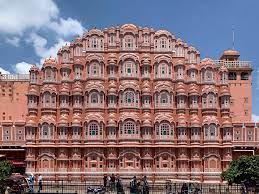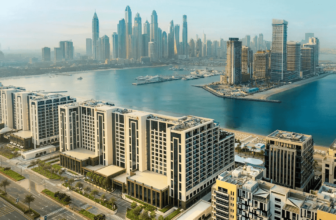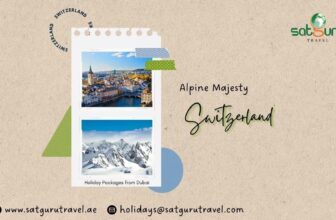
With its magnificent voyage across Rajasthan’s breathtaking scenery, rich cultural legacy, and historical grandeur, the Taj Mirror Tour Company’s Royal Rajasthan Tour is highly recommended. With its colorful cities, imposing forts and palaces, and distinctive customs, this well planned tour aims to give visitors a comprehensive understanding of the royal state. Royal Rajasthan Tour Check out this opulent tour in more detail:
First Day: Getting to Delhi
A representative from the Taj Mirror Tour Company will meet you at the airport and take you to your hotel as your tour starts in Delhi. Upon reaching the bustling capital of India, you have the option to either explore or unwind. Spend the night in Delhi.
Touring Delhi on Day Two
Take a full-day sightseeing tour of Delhi after breakfast, covering the following:
Mughal architecture at its most exquisite: the Red Fort, a UNESCO World Heritage Site.
The largest mosque in India is called Jama Masjid.
One of the UNESCO World Heritage Sites, Qutub Minar is the world’s tallest brick minaret.
Emblem of Mughal architecture, Humayun’s Tomb was built before the Taj Mahal.
Indian soldiers are honored at the India Gate, a war memorial.
India’s President resides in Rashtrapati Bhavan, his official residence.
Spend the night in Delhi.
Step 3: Delhi to Jaipur
Proceed towards Jaipur, the Pink City or Rajasthan’s capital, after breakfast. Check into your hotel as you arrive. Enjoy authentic Rajasthani food and stroll around the neighborhood markets in the evening. Be in Jaipur for the night.
Day 4: Scenic Tour of Jaipur
Enjoy a comprehensive day tour of Jaipur following breakfast, which includes:
Known for its creative Hindu-style components, Amber Fort is a magnificent fort situated atop a hill. Take pleasure in a jeep or elephant ride that leads to the fort.
Museums displaying items from Jaipur’s royal past can be found at City Palace, a royal home.
The UNESCO World Heritage Site Jantar Mantar is an observatory dedicated to astronomy.
The Palace of Winds, or Hawa Mahal, is a famous monument with a distinctive five-story façade.
Be in Jaipur for the night.
Jaipur to Jodhpur on Day 5
Head to Jodhpur, also called the Blue City, after breakfast. Check into your hotel as you arrive. Or just kick back at your accommodation. In the evening, explore the local markets. Be in Jodhpur for the night.
Day 6: Highlights of Jodhpur Tour
Visit the main points of interest in Jodhpur following breakfast, such as
The Mehrangarh Fort is one of the biggest forts in India. It has a museum with an extensive collection of antiques and breathtaking views of the city.
Beautiful marble cenotaph dedicated to Maharaja Jaswant Singh II is known as Jaswant Thada.
Currently home to a portion of its estate, Umaid Bhawan Palace is one of the biggest private homes in the world.
Be in Jodhpur for the night.
Day7: Travel from Jodhpur via Ranakpur to Udaipur
Visit Udaipur by car after breakfast. On the way, take in the breathtaking architecture and detailed marble sculptures of the Ranakpur Jain Temple. Proceed towards Udaipur further. Enjoy a relaxing evening after checking into your hotel upon arrival. Be in Udaipur for the night.
Day 8: Go Around Udaipur
Take a tour of the charming Udaipur, sometimes referred to as the City of Lakes, after breakfast. Your excursion consists of:
Beautiful views of Lake Pichola may be found at City royal, a magnificent royal complex featuring museums.
Relax and take in the beautiful views of the neighboring palaces while taking a leisurely boat ride on Lake Pichola.
Jagdish Temple: Sri Vishnu is the center of worship at this gigantic Hindu temple.
A medieval garden featuring lotus pools, fountains, and marble pavilions is called Saheliyon ki Bari.
Be in Udaipur for the night.
Days 9 and 10: Jaisalmer to Udaipur
Fly to the Golden City of Jaisalmer after breakfast. Check into your hotel as you arrive. Explore the neighborhood markets in the evening to get a taste of Jaisalmer’s interesting culture. Be in Jaisalmer for the night.
The tenth day: sightseeing in Jaisalmer
Tour Jaisalmer for the entire day after breakfast, taking in the following attractions:
Formerly called Sonar Quila, the Jaisalmer Fort is a live fort that is home to several stores, lodging facilities, and historic havelis.
Five havelis grouped together in Patwon ki Haveli, each with exquisite carvings and architecture.
Enjoy a traditional Rajasthani cultural show and a camel ride in the middle of the sand dunes at Sam Sand Dunes.
Be in Jaisalmer for the night.
Day11: From Jaisalmer to Bikaner
Visit Bikaner by car after breakfast. Check into your hotel as you arrive. Take in the lively ambiance of this desert city by visiting the local markets in the evening. Be in Bikaner for the night.
Day Twelve: Touring Bikaner
Visit the main points of interest in Bikaner following breakfast, such as:
Impressive fort with breathtaking architecture and a long history is Junagarh Fort.
Known by another name, the Rat Temple, Karni Mata Temple is well-known for its distinct community of sacred rats.
Rajput, Mughal, and European architectural styles are all blended together beautifully in Lalgarh Palace, a stunning palace constructed by Maharaja Ganga Singh.
Be in Bikaner for the night.
13th day: Bikaner to Delhi
Return to Delhi by car after breakfast. Check into your hotel as you arrive. Shopping or seeing more of Delhi’s sights can be your plans for the evening. Spend the night in Delhi.
14th day: Leaving Delhi
This concludes your Royal Rajasthan Tour. After breakfast, you will be driven to the airport for your next destination.
The Taj Mirror Tour Company: Why Choose Them?
Excellent service, well-informed guides, and meticulously designed itineraries are hallmarks of Taj Mirror Tour Company. Offering an opulent and all-encompassing tour of Rajasthan’s most prominent locations is the goal of the Royal Rajasthan Tour. All aspects of the trip are carefully planned to guarantee a remarkable experience, ranging from cozy lodging and seamless transportation to informative tours and delectable meals.
With this tour, guests will get an unparalleled experience as it perfectly combines historical exploration, cultural immersion, and Rajasthan’s distinct charm.
ALSO READ-
Bolivia: A Beautiful Country with An Abundant Culture
In the center of South America is the nation of Bolivia, which is remarkably diverse. Bolivia provides both tourists and locals a singular and enthralling experience because of its breathtaking scenery and rich cultural legacy. The geography, history, culture, and contemporary lifestyle of Bolivia will all be covered in this article.
Geographical Synopsis
The Place and the Terrain
Peru, Brazil, Paraguay, Argentina, Chile, and Chile all abut Bolivia, a landlocked nation. From the lofty summits of the Andes mountains to the enormous stretches of the Amazon jungle, its topography is extraordinarily varied. The high plateau of the Altiplano, the Andes, and the lowland plains make up the three primary geographic regions of the country.
Significant Landmarks
The largest salt flats in the world, the Uyuni Salt Flats, and Lake Titicaca, the highest navigable lake in the world, are two notable natural monuments. One of the planet’s most biodiverse regions is the Madidi National Park, which is a portion of the Amazon basin.
Ancient Civilizations: Historical Context
Ancient civilizations, particularly the Inca and Tiwanaku empires, have left a rich legacy in Bolivia’s past. These early occupants’ sophisticated engineering and building abilities are demonstrated by the remains of Tiwanaku, which are located close to Lake Titicaca.
Time of the Colonials
Bolivia had substantial changes as a result of Spanish colonization in the sixteenth century. Potosí’s plentiful silver mines made it one of the richest towns in the world during the colonial era.
Individualism and Contemporary History
In 1825 Bolivia broke away from Spanish rule. Instability in politics and economic hardships have characterized the nation’s modern history. In recent times, Bolivia has made noteworthy advancements in both social and economic domains.
The Cultural Legacy
Variety of Ethnicities
With a rich fusion of indigenous cultures, Bolivia is home to a diverse populace. The nation honors its eclectic past by designating 36 official indigenous languages in addition to Spanish.
Traditions and Festivals
A UNESCO Masterpiece of the Oral and Intangible Heritage of Humanity, Carnival in Oruro is one of Bolivia’s most colorful celebrations. Additional noteworthy cultural celebrations comprise the Alasitas Fair in La Paz and the Andean New Year, or Año Nuevo Andino.
Market Economy
Biological Resources
The natural resources of Bolivia, especially natural gas, minerals, and lithium, are very important to the country’s economy. For the sake of the world’s battery sector, the nation possesses some of the world’s largest reserves of lithium.
Industrial and Agricultural Production
Soybeans, quinoa, and coffee are important exports from agriculture, which is also essential to the economy. With tourism and industry playing a bigger role in economic growth, the industrial sector is expanding.
Popular Tourist Spots
Adventurers will find paradise in Bolivia. For its stunning scenery, the Salar de Uyuni is a must-see. Owing to its high altitude and lively street life, La Paz provides a singular experience. Ecotourism and animal observation are made possible by the Amazon jungle.
Adventure Sports
Explore the colonial architecture of Sucre, travel through the Andes, or explore the historic silver mines of Potosí are just a few of the activities available to tourists.
Recipes: Classic Meals
Flavorful and varied, Bolivian food includes meals like silpancho (breaded meat with rice and potatoes), anticuchos (grilled meat skewers), and salteñas (savory pastries). A range of potatoes and other indigenous ingredients are frequently used.
Consumption
Traditional drinks made from corn, such as singani, or brandy, and chicha are popular choices. Additionally popular, especially in high-altitude areas, is coca tea, which is produced from coca leaves.
Curriculum
First and Second Grade Education
For youngsters up to the age of 14, Bolivia provides free and required schooling. Particularly in rural areas, the government has made investments to increase access to education and improve the literacy rate.
Advancement of Knowledge
Many universities are located around the nation, the most esteemed of which is the University of San Andrés in La Paz. Improvements in accessibility and quality have been made to higher education through reform.
Political Organization and System of Government
The presidential republic of Bolivia is unitary. Chief of state and head of government is the President. With recent initiatives concentrated on social inclusion and indigenous rights, the nation has seen substantial political shifts.
Current Progress
With measures targeted at lowering poverty and enhancing infrastructure, Bolivia has been working toward social improvement and economic stability in recent years.
The atmosphere and climate
Temperature Zones
Each region of Bolivia has a very different climate. The climate in the lowland regions is tropical, but that in the Altiplano is chilly and dry. With a humid, subtropical climate, the Yungas region is situated between the Andes and the Amazon.
Natural Difficulties
Deforestation, the effects of mining, and problems with water management are some of the environmental difficulties Bolivia faces. Addressing these issues and safeguarding the nation’s abundant biodiversity are the goals of ongoing conservation initiatives.





